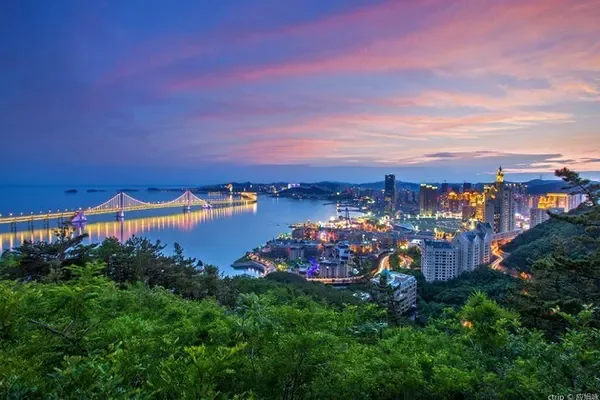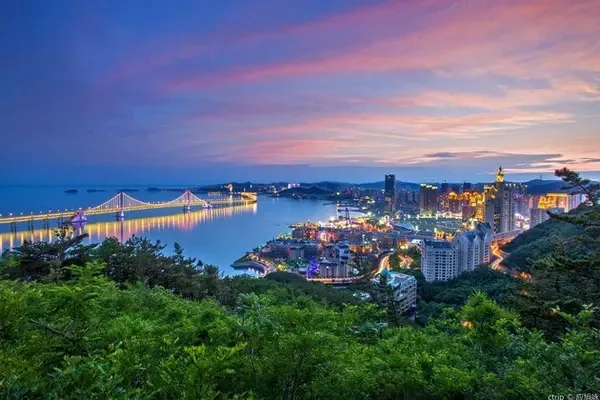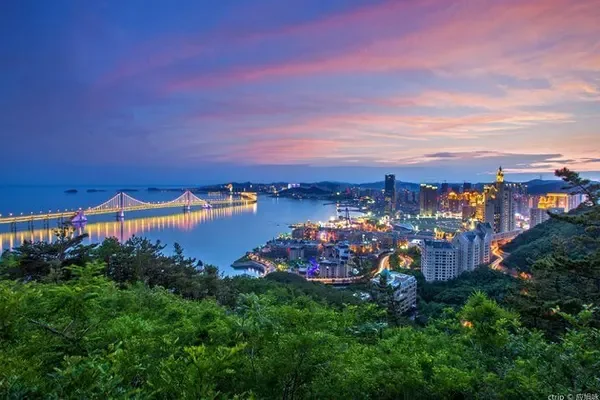Colorful, mysterious, majestic, and steep... The vigor and magnificence of the west is a kind of broad mind that must be seen when looking up. People are excited, people shout, people follow.
Ningxia has a height and breadth that perfectly match the world of martial arts. The mountains, plains, deserts, rivers, and all the uncanny workmanship of nature here fully demonstrate the height and breadth. When you are in this place, you also have a sense of time travel. In this desolate world, there is indeed a sense of martial arts...
Three-day itinerary:
Zhenbeibao Western Film and Television City: masterpieces "Journey to the West"/"Red Mountain Bridge"/"The Old Man and the Dog"
Shuidonggou: masterpiece "A Chinese Journey to the West"/"Jin Yiwei"/"Fortune Inn"
Xixia Mausoleum: "Longling Grottoes"
Shapotou District, Zhongwei: "The Tomb of Thorns"
Huoshi Village: "Asura"
1/Zhenbeibao Western Film City: 56 kilometers away from Yinchuan City, there are direct vehicles at the south gate of Yinchuan and the railway station
The yellow sand blows through the desolate west. For thousands of years, the story of Ningxia has never stopped. Speaking of the origin of martial arts and Ningxia, many people's basic knowledge starts from the western film and television city of Zhenbeibao. Zhenbei Fort was originally a dilapidated border city built during the Ming and Qing Dynasties. The city wall is said to be rammed with loess and glutinous rice, and there is hardly a single brick. After hundreds of years of hammering, the wall is full of holes and gullies.
Zhenbeibao Western Film City is 25 kilometers away from Yinchuan Railway Station and 60 kilometers away from Hedong Airport. It is the place where Chinese movies go to the world from here. More than 200 film and television dramas such as "The Wrangler", "Red Sorghum", and "A Chinese Journey to the West" have been filmed here, which have won international and domestic awards. Zhenbeibao Western Film City is characterized by simplicity, primitiveness, roughness, desolation and folk among many film and television cities in China. . In 2009, it was designated as a national 5A-level tourist attraction.
I don’t know if you still remember that classic dialogue: Once there was a sincere love in front of me, I didn’t cherish it, and I regretted it when I lost it. The most painful thing in the world is nothing more than this. Once I have a chance, I will tell that girl I love you. If I want to add a time limit to this love, I hope it will be 10,000 years.
Film and Television City - Shuidonggou 75 kilometers, 1.5 hours by car
2/ Shuidonggou Go through the earth forest for thousands of years. Geographically, Shuidonggou is located in Linhe Town, Lingwu City, which seems to be far away. In fact, it is the closest 5A scenic spot to Yinchuan City.
Transportation: Self-driving: 1/Yinchuan Dongshangyinqing Expressway, about 10 minutes after getting off the expressway at Shuidonggou exit, you can reach the scenic spot directly
2/ Drive from Petroleum City to the Second Yellow River Bridge, and after arriving at the Second Bridge, go straight for 9 kilometers to reach the scenic spot
Self-help: There are direct trains to the scenic spot at the railway station and the North Gate Tourist Bus Station.
Tickets for Shuidonggou are 60 yuan, and all-in-one tickets (tickets + scenery + entertainment) are 180 yuan. I heard that there was a performance "Northern Xinjiang Tiange" that was very good. Unfortunately, due to the epidemic this year, Mongolian actors could not enter and did not see it. Pity! ! !
In 1923, French paleontologists Teilhard and Sang Zhihua discovered prehistoric cultural sites in Linhe Town, Lingwu City, 19 kilometers away from Yinchuan City. Through excavation, a large number of stone tools and animal fossils were unearthed. Therefore, Shuidonggou became the earliest ancient human cultural site discovered in the Paleolithic Age in my country, and it also confirmed that it was a holy place for human reproduction 40,000 years ago.
Shuidonggou is a grand view garden of military defense buildings such as the ancient Great Wall, beacon towers, castles, ditches, and piers in the Ming Dynasty in northern my country. In the protected area, the Great Wall winding east, the towering piers, the simple and mysterious castles, and the winding and deep trenches are dizzying. It makes people think of "soldiers with spears galloping to battle fortresses, and generals chasing soldiers with swords." heroic scene.
This is the main location for filming "A Chinese Journey to the West", just the scene where Zhou Xingchi and Karen Mok play against each other.
The beauty of Shuidonggou begins with clumps of reeds.
Shuidonggou Tourism
There is a three-kilometer-long Luhua Valley, and September in early autumn has the most comfortable climate of the year among the local population. The reeds are swaying, sitting in the carriage and shuttling among them, under the blue sky, there is a swaying reed sway, with a swaying body and a flying mood...
Stills of Jin Yiwei
Shuidonggou——Xixia Mausoleum 60 kilometers
3/ Xixia Mausoleum
Tickets 90 yuan
The Xixia Mausoleum is the tomb of the emperors and royal tombs of the Xixia Dynasty. The Royal Mausoleum is located in the west of Yinchuan City, Ningxia, adjacent to Helan Mountain in the west and Yinchuan Plain in the east, with an altitude of 1130 meters to 1200 meters. It is one of the largest and most complete imperial cemeteries in China and the largest existing Xixia cultural relics. The Xixia Mausoleum was built from about the beginning of the 11th century to the beginning of the 13th century. Influenced by Buddhist architecture, Xixia Mausoleum organically combines Han culture, Buddhist culture, and Dangxiang culture, forming a unique form of Chinese cemetery architecture. Among the 119 national key scenic spots in China, the Xixia Mausoleum is the only scenic spot composed of a single emperor's tomb. It inherits the history of the Tuoba clan of Xianbei from Pingcheng in the Northern Wei Dynasty to Dangxiang Xixia. The scenic spot covers an area of more than 58 square kilometers, and the core scenic spot is 20.9 square kilometers. There are 9 emperor tombs and more than 200 burial tombs of princes and relatives. The scale is magnificent and the layout is strict. Each imperial mausoleum is an independent building group in a vertical rectangle facing north and south, and its scale is comparable to that of the Ming Tombs. Since the Qin and Han Dynasties, it has absorbed the directors of the imperial tombs of the Tang and Song Dynasties, and has been influenced by Buddhist architecture to form a unique form of Chinese cemetery architecture, so it is called the Oriental Pyramid.
The cultural and creative products developed by the scenic spot, the character modeling is quite characteristic of the times.
This is Jialing Pinjia, a divine bird in the Xixia period, which is said to be able to sing beautifully.
Yinchuan - Zhongwei 280 kilometers,
Zhongwei Shapotou
The ticket for Shapotou scenic spot is 100 yuan, and there are still sandboarding/camel riding/bungee jumping in the scenic spot.
One of the filming locations of "Where Are We Going, Dad"
One of the characteristics of Shapotou is sand boarding and sand climbing. Tourists climb step by step from the flat ground to the top of Shapotou, which is about 100 meters high (you can also take the cableway) and slide down. Due to the special geographical environment and geological structure, there will be a strange sound under the seat when sliding on the sand. , the human bell and the huge drum are dull and vigorous, which is called "Jinsha Ringing Bell". Climbing sand mountains can best exercise people's perseverance and endurance. Some people wear sand-proof shoe covers, but most of them are barefoot. When your feet are crawling on the soft sand, don't have a lot of fun! Note: You can't climb the sand hill when the sun is very poisonous. Here is the largest sand skiing field in China, nearly 200 meters long and 80 meters high. If the weather is fine and the temperature rises, when you slide down from Shapotou, there will be a "humming" roar in the slope, just like the long ringing of a golden bell, so it is known as "Shapo Ringing the Bell", and it is one of the four big ringing sands in China. .
The second characteristic of Shapotou is that to the north of the sand mountain is the vast Tengger Desert. To the south of Shapotou is a lush desert oasis. Visitors can not only enjoy the scenery of the great desert here, but also look at the miracle of Baolan Railway stretching across the desert like a green dragon; they can also ride camels in the desert, take photos, and enjoy the taste of desert travel.
"Assassin's Tomb" was also filmed in Zhongwei
Zhongwei - Huoshizhai 280 kilometers
After getting off the expressway at the exit of Sanying, there are about 20 kilometers of rural roads. The roads are in good condition, but they are close to the village. Be careful when driving. The most beautiful scenery is on the road. There are barrier lakes formed by the 1920 earthquake, deep and shallow reeds, and the majestic and vigorous Moon Mountain range. Windmills dance in the mountains. It may be because I was nostalgic for the scenery, but ignored the distance, so I soon arrived at the Huoshizhaizi scenic spot.
The entire Huoshizhai Mountain Range has red and purple-red cliffs, peaks, ridges, and strange rocks protruding from the Loess Plateau, and the landscape is spectacular and beautiful. Also because the red sandstone is exposed, the locals call it Huoshizhai. It is the highest Danxia landform group in China, known as China's "Grand Canyon of Colorado"!
When you come to Huoshizhai, you must experience a high-altitude glass suspension bridge.
The length of the "glass suspension bridge" is 268m, and the bridge body and the ground are as high as 118m. The two ends of the suspension bridge are made of wooden structures, and the middle is designed with "transparent glass". 30 meters, located between the golden summit of the main peak of Yuntai Mountain in Huoshizhai and the opposite Wangxia Pavilion.
Stills of the movie "Asura"
Featured hotels:
After playing Shuidonggou on the first day, I happened to live in the scenic spot.
Shuidonggou Wild Luxury Tent Hotel:
Price: 458 yuan / room
Although it is a tent, the facilities inside are the same as those of a star hotel, with 24 hours of hot water and a separate toilet. The hotel is on the border of Ningxia and Inner Mongolia, away from the city, very quiet.
In Zhongwei, you must live in the Desert Star Hotel. The hotel is in the Shapotou Scenic Area.
The Star Hotel is 1680 yuan per room, suitable for family trips and girlfriend trips. This hotel is very popular. If you choose to go to Ningxia from May to October, remember to book in advance!
The hotel includes breakfast, buffet, not bad, in addition to 298 self-service small hot pot.



